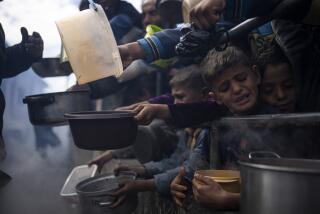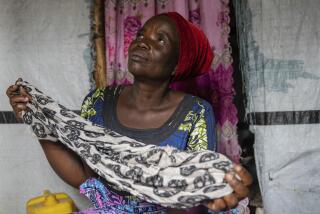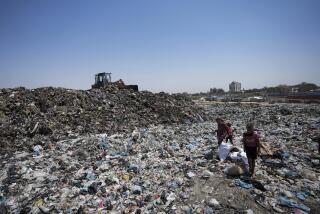75% of Somali Children May Die, Official Warns : Africa: American calls it the ‘worst humanitarian disaster.’ He says U.N. must restrain looters to let food and medicine reach the starving.
WASHINGTON — A Bush Administration official warned Monday that three-quarters of Somalia’s children may die in the next six months unless U.N. guards restrain looters enough to let food and medicine reach the starving and sick.
James Kunder of the U.S. Agency for International Development, the first top American official to reach Somalia in a year and a half, described the situation in the ravaged East African country as “the world’s worst humanitarian disaster.”
Kunder, who directs AID’s Office of Foreign Disaster Assistance, at a briefing endorsed a U.N. plan to send guards to the Somali capital of Mogadishu to force distribution of the supplies now bottled up in the port by two rival and belligerent tribal sub-clans.
Insisting that lack of security is the main reason Somalis are starving and dying of illness, the AID official cited a flagrant example of the problem. “Seven thousand tons of food are spilling out of the docks of Mogadishu while Somalis starve a kilometer away,” he said.
Mogadishu has been ravaged and paralyzed by an incessant civil war between the two sub-clans that seems to defy logic and lack any ethnic base.
“Not only are they from the same tribe,” a U.N. official said of the two warring factions recently after several trips there.
“Not only do they speak the same language and have the same ethnicity--(but) there is not one shred of difference between them ideologically. They are only interested in power, and it cannot be shared.”
The crisis has received new attention in recent weeks largely through the efforts of U.N. Secretary General Boutros Boutros-Ghali, who has accused Westerners of focusing so hard on the problems of Yugoslavia and its breakaway republics that they have blinded themselves to the even more terrible loss of life in the Horn of Africa.
Kunder, who had just spent two days in Somalia as part of a study of relief problems in East Africa, said that heavy artillery shelling has stopped under a U.N.-mediated cease-fire but that armed bands continue to wander through Mogadishu, looting food and terrorizing civilians.
“There are an awful lot of armed people on the street,” he said. “There are heavy weapons on the street corners. There is firing in the air. Thirty to 40 casualties a day are coming into one of Mogadishu’s three hospitals. I would paint the security picture in general as one of chaos.”
The AID official offered an array of grim statistics. He said a quarter of Somalia’s population of 6.5 million faces starvation. The figures for children under 5 are worse. He said AID’s best guess is that a quarter of the children have died already and that, in all, three-quarters will die in six months unless the food pipeline is unclogged.
Furthermore, he said, more than 800,000 Somalis have fled to Ethiopia, Kenya, Djibouti and Yemen. He described the Kenyan refugee camps, which he had just toured, as “terrible, horrible.” A thousand Somalis are crossing the border into northern Kenya every day, he said, and Kenya does not have the resources to cope with them.
Kunder said U.N. experts believe that security could be established at the Mogadishu docks with 500 guards. But Reuters news agency reported that Mohammed Sahnoun, the Algerian diplomat who is the U.N. special representative in Somalia, now believes that several thousand may be needed to ensure that relief supplies reach those in need.
Working through international agencies such as the International Committee of the Red Cross and the Office of the U.N. High Commissioner for Refugees, the U.S. government, according to Kunder, has donated $77 million for food relief, shipments of medical supplies and airlifts.
Kunder said that only 15,000 tons of food have been reaching the hungry in Somalia every month, less than half of the 35,000 tons needed, according to Red Cross estimates. But he emphasized that relief for Somalia hinges far more on a reduction in looting than on an increase in food.
He said that 150,000 to 200,000 tons of food are “in the pipeline,” ready to move into Somalia if secure routes can be found from Mogadishu to relief workers in the field.
When food reaches relief workers, he said, “most of it does get through to the people.”
Kunder said Somalia now has no other economy except relief. The economy, he explained, “consists either in protecting relief food--that is, the hiring of armed guards for relief convoys--or (in) attacking those convoys.”
“We need to examine ways to bring Somali merchants into the food distribution process,” he went on, “both in order to move more food into the country and to generate currency, local currency, to provide jobs and earnings in the marketplace.”
More to Read
Sign up for Essential California
The most important California stories and recommendations in your inbox every morning.
You may occasionally receive promotional content from the Los Angeles Times.










